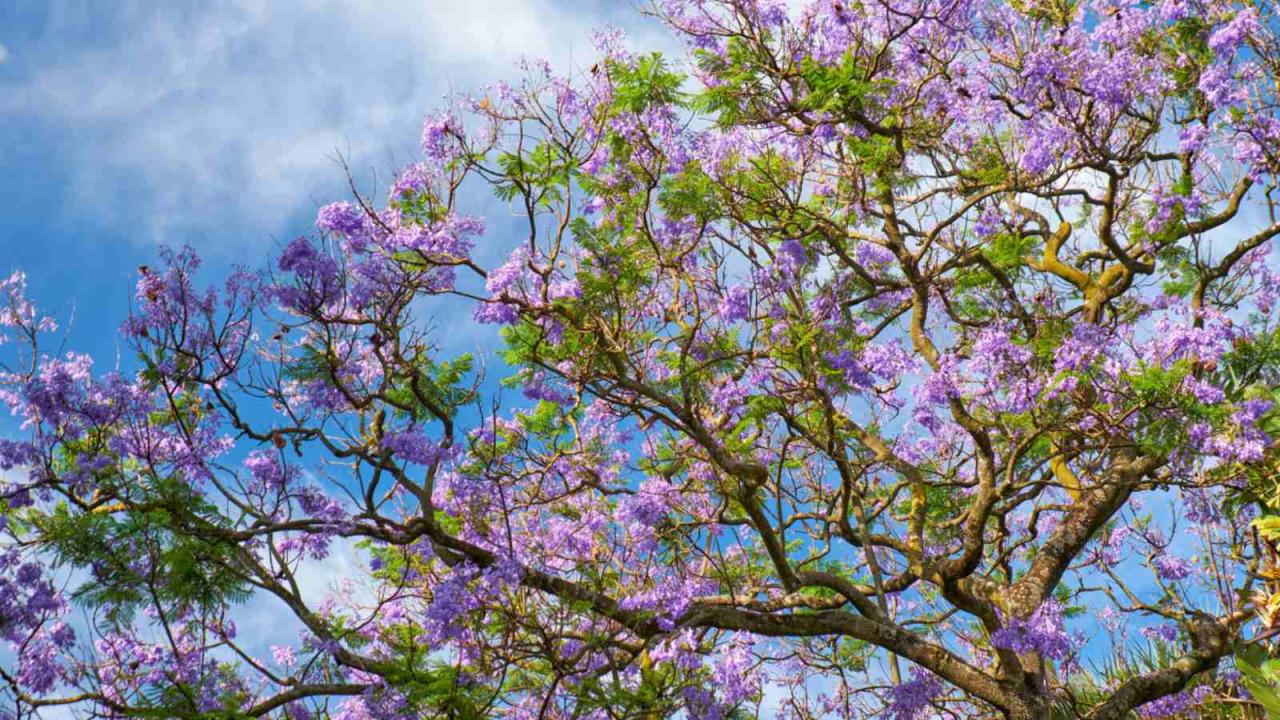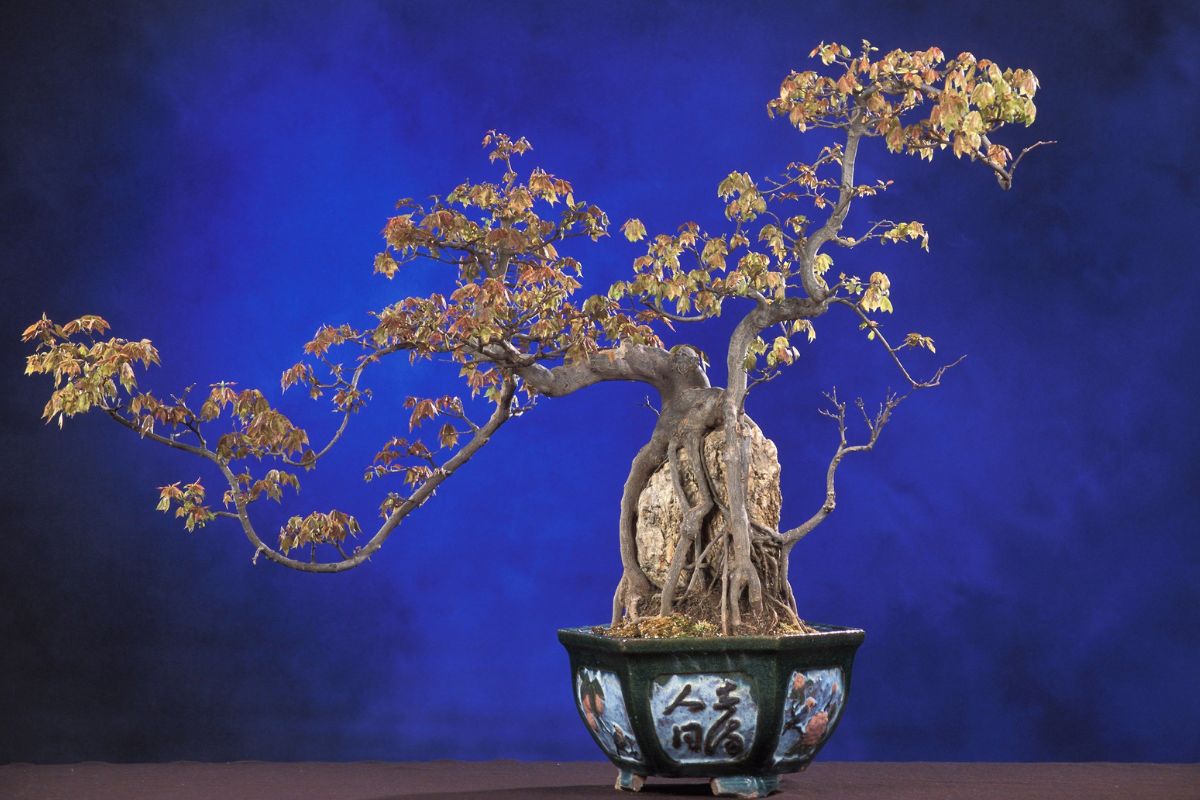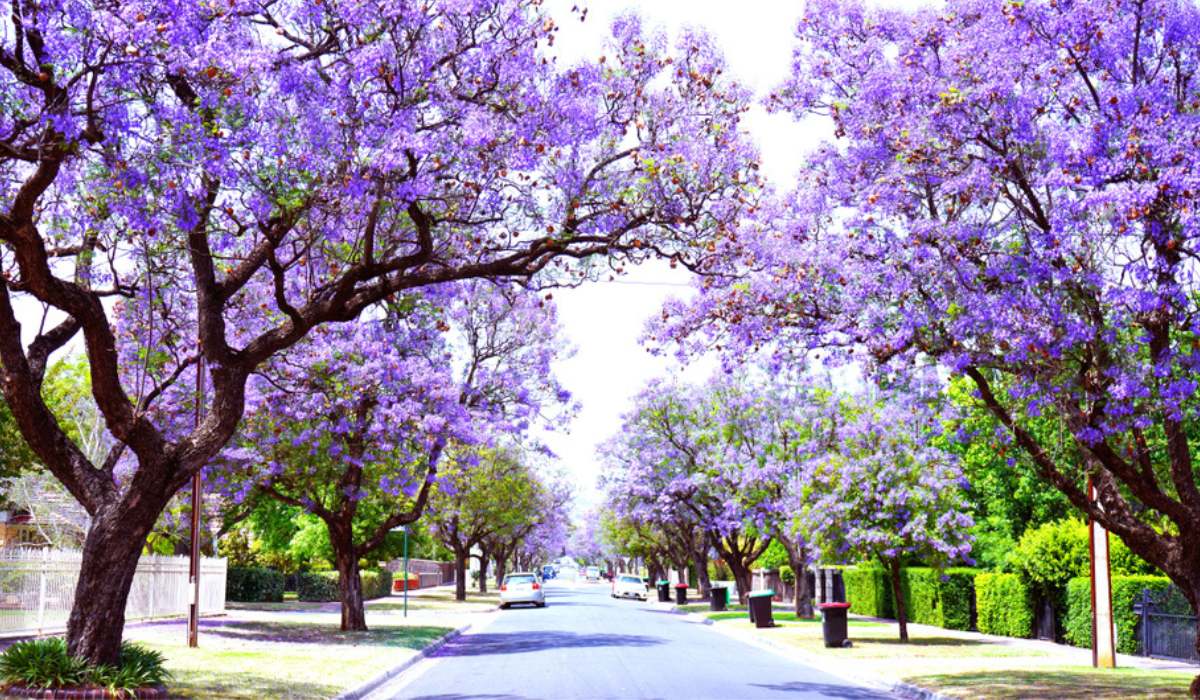How to Achieve a Beautiful Garden Feature with Jacaranda Tree: Essential Tips and Techniques – Imagine a garden where vibrant purple blooms cascade from a majestic tree, creating a captivating focal point. The Jacaranda, with its striking beauty and ethereal presence, is a coveted choice for garden enthusiasts seeking to transform their outdoor spaces.
This comprehensive guide explores the art of incorporating Jacaranda trees into your garden design, providing essential tips and techniques for achieving a breathtaking feature.
From selecting the perfect location and planting techniques to nurturing your Jacaranda tree and creating a harmonious garden landscape, this guide covers every aspect of incorporating this remarkable tree into your outdoor oasis. Discover the diverse varieties of Jacaranda trees, their suitability for different climates, and how to design captivating garden features that showcase their beauty.
Introduction to Jacaranda Trees

Jacaranda trees are renowned for their breathtaking beauty, transforming landscapes into vibrant canvases of color. These captivating trees, native to South America, are a beloved choice for gardeners seeking to add a touch of tropical elegance to their outdoor spaces.
Jacaranda trees are highly sought after for their striking floral displays. During the spring and summer months, these trees erupt in a cascade of vibrant blue or purple flowers, creating a mesmerizing spectacle that draws attention from afar. The delicate, trumpet-shaped blossoms cluster together in large, showy panicles, blanketing the tree in a sea of color.
This dazzling display of blooms adds a touch of magic to any garden, making Jacaranda trees a popular choice for both residential and commercial landscaping.
Varieties of Jacaranda Trees, How to Achieve a Beautiful Garden Feature with Jacaranda Tree: Essential Tips and Techniques
Jacaranda trees offer a range of varieties, each with its own unique characteristics and suitability for different climates. Understanding the different types of Jacaranda trees is essential for selecting the best variety for your garden.
- Jacaranda mimosifolia:This is the most common and widely cultivated species of Jacaranda tree. It is known for its fast growth rate, reaching heights of up to 50 feet. Jacaranda mimosifolia is a popular choice for warmer climates, as it thrives in full sun and well-drained soil.
Its stunning blue-violet flowers bloom in late spring and early summer, creating a breathtaking display.
- Jacaranda acutifolia:This variety is native to Mexico and is known for its smaller size, reaching heights of around 30 feet. Jacaranda acutifolia is also more cold-tolerant than other species, making it suitable for cooler climates. Its flowers are a deep violet-blue color and bloom in late spring and early summer.
- Jacaranda oxyphylla:This variety is native to Australia and is known for its delicate, fern-like foliage. Jacaranda oxyphylla is a smaller tree, reaching heights of around 20 feet. Its flowers are a pale blue color and bloom in late summer and early autumn.
Planning Your Jacaranda Garden Feature: How To Achieve A Beautiful Garden Feature With Jacaranda Tree: Essential Tips And Techniques

Planning is crucial for achieving a beautiful and thriving Jacaranda garden feature. It ensures that your tree thrives and complements your existing landscape. Consider these essential factors when planning:
Choosing the Right Location
The location you choose for your Jacaranda tree significantly impacts its growth and overall health. Jacarandas thrive in warm climates and require ample sunlight and well-drained soil.
- Sunlight:Jacaranda trees need at least 6 hours of direct sunlight daily. Choose a location that receives full sun exposure, especially during the hottest part of the day. Avoid planting them in shady areas, as they may struggle to grow and flower properly.
- Soil Type:Jacarandas prefer well-drained soil that is slightly acidic to neutral. They do not tolerate waterlogged conditions, so ensure the soil drains well. If your soil is heavy clay, amend it with compost or other organic matter to improve drainage.
- Space Requirements:Jacaranda trees can grow quite large, reaching heights of up to 60 feet and spreading out to 40 feet. Choose a location that provides enough space for the tree to mature without encroaching on structures, walkways, or other plants.
Planting Time and Site Preparation
The ideal time to plant a Jacaranda tree is during the spring or early summer when the soil is warm and the weather is favorable.
- Preparing the Planting Site:Before planting, prepare the planting site by removing any weeds, rocks, or debris. Dig a hole twice as wide and as deep as the root ball. Amend the soil with compost or other organic matter to improve drainage and fertility.
- Planting the Tree:Gently loosen the roots of the Jacaranda tree and place it in the hole, ensuring that the root flare (the point where the roots transition into the trunk) is level with the ground. Backfill the hole with the amended soil, firming it gently around the roots.
While Jacaranda trees are renowned for their stunning purple blooms, they also offer a unique opportunity to enhance your garden’s aesthetic appeal. By understanding the right planting techniques and care, you can cultivate a vibrant and captivating focal point.
Just as you can explore the culinary versatility of perilla leaves, as outlined in this informative guide How to Make the Most of Perilla Leaf in Your Dishes: Expert Tips and Recipes , you can also experiment with different pruning methods and companion plants to create a harmonious and breathtaking garden feature around your Jacaranda tree.
Water the tree deeply after planting.
Complementary Garden Design
Enhance the beauty of your Jacaranda tree by incorporating contrasting colors and textures into your garden design.
- Color Contrast:The vibrant purple flowers of the Jacaranda tree stand out beautifully against a backdrop of green foliage. Plant contrasting colors like bright yellow, orange, or red to create a striking visual effect.
- Texture Contrast:The delicate, feathery foliage of the Jacaranda tree provides a soft texture. Complement this with plants that have contrasting textures, such as coarse-leaved plants like ferns or succulents.
- Consider the Shape:Jacarandas have a rounded shape, so consider planting other trees or shrubs with contrasting shapes, such as upright conifers or weeping willows, to create visual interest.
Planting and Caring for Your Jacaranda Tree

Planting a Jacaranda tree is a rewarding experience, bringing a touch of tropical beauty to your garden. With proper planting techniques and ongoing care, you can ensure your Jacaranda thrives and becomes a focal point in your landscape.
While Jacaranda trees offer a stunning display of purple blooms, you can also add a touch of exotic elegance with the Papyrus plant. This unique plant, often used in ancient Egyptian rituals, can be easily cultivated and maintained for a dramatic and architectural presence in your garden, as detailed in Papyrus Plant Magic: How to Cultivate and Maintain This Beautiful Herb Effectively.
Integrating both the Jacaranda and Papyrus will create a truly unique and captivating landscape, offering a blend of vibrant colors and textural contrast.
Planting a Jacaranda Tree
Planting a Jacaranda tree involves selecting the right location, preparing the soil, and planting the tree correctly. Here’s a step-by-step guide:
- Choose a sunny location: Jacaranda trees require at least 6 hours of direct sunlight daily to flourish. They prefer well-drained soil and can tolerate a range of soil types, but they don’t thrive in waterlogged conditions.
- Prepare the planting hole: Dig a hole twice as wide and as deep as the root ball of the Jacaranda tree. This allows the roots to spread out freely and encourages healthy growth.
- Amend the soil: Jacaranda trees benefit from well-drained soil enriched with organic matter. Mix compost or aged manure into the soil at the bottom of the planting hole to improve drainage and provide essential nutrients.
- Position the tree: Carefully place the Jacaranda tree in the planting hole, ensuring the root ball is level with the surrounding soil. Avoid planting the tree too deeply, as this can suffocate the roots.
- Backfill the hole: Gently backfill the hole with the amended soil, ensuring there are no air pockets. Firm the soil around the base of the tree to provide support.
- Water thoroughly: After planting, water the Jacaranda tree deeply to settle the soil and encourage root growth. Continue watering regularly, especially during the first year after planting, to establish a strong root system.
Caring for a Young Jacaranda Tree
Providing proper care to a young Jacaranda tree is crucial for its healthy development. This involves regular watering, fertilizing, and pruning.
- Watering: Young Jacaranda trees need consistent watering, especially during the first year after planting. Water deeply and infrequently, allowing the soil to dry out slightly between waterings. During hot, dry periods, you may need to water more frequently.
- Fertilizing: Feed your Jacaranda tree with a balanced fertilizer formulated for trees. Apply fertilizer in spring and early summer, following the manufacturer’s instructions. Avoid over-fertilizing, as this can damage the tree.
- Pruning: Prune your Jacaranda tree in late winter or early spring before new growth emerges. Remove any dead, diseased, or damaged branches. You can also prune to shape the tree and encourage bushier growth.
Common Problems and Solutions
While Jacaranda trees are generally hardy, they can be susceptible to certain pests and diseases.
- Pests: Common pests that may affect Jacaranda trees include aphids, mealybugs, and scale insects. These pests can be controlled with insecticidal soap or horticultural oil.
- Diseases: Jacaranda trees can be affected by fungal diseases such as leaf spot and root rot. Good drainage and proper watering practices can help prevent these diseases. If fungal diseases occur, you can treat them with fungicides.
Designing a Beautiful Jacaranda Feature
A Jacaranda tree’s captivating beauty can be the focal point of a stunning garden feature. Its vibrant purple blooms and delicate foliage create a unique ambiance, inviting you to design a space that reflects your personal style and blends seamlessly with the tree’s natural charm.
Jacaranda Garden Feature Ideas
To help you visualize the possibilities, here’s a table showcasing various garden feature ideas incorporating Jacaranda trees:
Feature Type |
Description |
Materials |
Tips for Implementation |
|---|---|---|---|
Shaded Seating Area |
Create a relaxing retreat under the Jacaranda’s canopy. Place comfortable seating, such as a hammock, bench, or chairs, strategically beneath the tree. |
|
|
Walkway with Jacaranda Canopy |
Design a pathway that winds through the Jacaranda’s branches, creating a picturesque walkway adorned with its vibrant blossoms. |
|
|
Garden Bed with Contrasting Plants |
Create a vibrant garden bed around the Jacaranda, showcasing contrasting colors and textures. Use plants with foliage in shades of green, silver, or gold to complement the Jacaranda’s purple blooms. |
|
|
Enhancing the Beauty of Your Jacaranda Feature
Creating a stunning Jacaranda garden feature involves not only the tree itself but also the complementary elements that enhance its beauty and create a harmonious garden landscape. By thoughtfully incorporating plants, hardscaping, and lighting, you can transform your Jacaranda tree into a captivating focal point.
Utilizing Complementary Plants and Flowers
Adding complementary plants and flowers to your Jacaranda feature can create a visually appealing and diverse landscape. These plants can enhance the beauty of the Jacaranda tree by providing contrasting colors, textures, and shapes.
- Bright and Colorful Companions:Consider planting vibrant flowers like zinnias, sunflowers, or cosmos around the base of the Jacaranda tree. Their bright colors will create a striking contrast against the purple blossoms, adding a burst of energy to the space.
- Foliage Contrast:To create visual interest, incorporate plants with contrasting foliage textures and colors. Ferns, with their delicate fronds, can provide a soft contrast to the Jacaranda’s bold leaves. Variegated foliage plants, like Hostas with their white-edged leaves, can add a touch of elegance.
- Ground Cover:A ground cover like creeping phlox or thyme can create a beautiful and low-maintenance base around the Jacaranda tree, suppressing weeds and adding a layer of texture.
Incorporating Hardscaping Elements
Hardscaping elements can add structure, functionality, and visual appeal to your Jacaranda garden feature.
- Paths and Walkways:A winding path leading to the Jacaranda tree can invite visitors to explore the space and appreciate its beauty. Consider using natural materials like stone or gravel for a rustic look or pavers for a more formal feel.
- Benches and Seating Areas:Place benches or seating areas under the canopy of the Jacaranda tree, creating a relaxing spot to enjoy the shade and the beauty of the flowers. Choose materials that complement the surrounding landscape, such as wood, metal, or stone.
- Water Features:A small fountain or pond near the Jacaranda tree can add a soothing element to the space. The sound of flowing water can create a peaceful ambiance, while the reflection of the Jacaranda blossoms in the water can enhance the visual appeal.
Lighting Your Jacaranda Feature
Illuminating your Jacaranda feature at night can create a magical atmosphere and highlight its beauty.
- Uplighting:Uplighting the Jacaranda tree from the ground can create a dramatic effect, highlighting the tree’s silhouette and its blossoms. Use low-voltage landscape lighting fixtures with warm white or amber bulbs to create a soft, inviting glow.
- Spotlighting:Spotlights can be used to focus attention on specific areas of the tree, such as the trunk or the branches with the most blossoms. Choose spotlights with adjustable beams to create a focused and dramatic effect.
- Path Lighting:Path lighting can guide visitors through the garden and highlight the beauty of the Jacaranda tree. Use low-voltage pathway lights or solar-powered lights for energy efficiency.
Last Recap
With a little planning and care, you can create a stunning Jacaranda garden feature that will bring joy and beauty to your outdoor space for years to come. By understanding the unique characteristics of Jacaranda trees, choosing the right location, and implementing the proper care techniques, you can unlock the full potential of this magnificent tree and create a garden masterpiece that will be the envy of your neighbors.
FAQ Section
What is the best time to plant a Jacaranda tree?
The ideal time to plant a Jacaranda tree is during the spring or early summer when the soil is warm and the weather is mild.
How often should I water my Jacaranda tree?
Young Jacaranda trees need regular watering, especially during the first year after planting. Established trees are more drought-tolerant but benefit from occasional watering during dry spells.
Do Jacaranda trees attract pests or diseases?
Jacaranda trees are generally pest and disease resistant. However, they can be susceptible to certain pests and diseases, such as aphids, scale insects, and leaf spot disease. It’s important to monitor your tree regularly for any signs of infestation or disease.
Can I prune my Jacaranda tree?
Pruning Jacaranda trees is generally not necessary, as they naturally develop a beautiful, rounded shape. However, you can prune them to remove dead or damaged branches or to control their size and shape.
